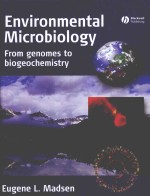

ENVIRONMENTAL MICROBIOLOGY FROM GENOMES TO BIOGEOCHEMISTRYPDF电子书下载
- 电子书积分:15 积分如何计算积分?
- 作 者:EUGENE L.MADSEN
- 出 版 社:BLACKWELL PUBLISHING
- 出版年份:2008
- ISBN:1405136472
- 页数:479 页
1 Significance, History, and Challenges of Environmental Microbiology 1
1.1 Core concepts can unify environmental microbiology 1
1.2 Synopsis of the significance of environmental microbiology 2
1.3 A brief history of environmental microbiology 6
1.4 Complexity of our world 10
1.5 Many disciplines and their integration 12
2 Formation of the Biosphere: Key Biogeochemical and Evolutionary Events 23
2.1 Issues and methods in Earth′s history and evolution 24
2.2 Formation of early planet Earth 24
2.3 Did life reach Earth from Mars? 26
2.4 Plausible stages in the development of early life 29
2.5 Mineral surfaces: the early iron/sulfur world could have driven biosynthesis 33
2.6 Encapsulation: a key to cellular life 34
2.7 A plausible definition of the tree of life′s "last universal common ancestor" 35
2.8 The rise of oxygen 36
2.9 Evidence for oxygen and cellular life in the sedimentary record 37
2.10 The evolution of oxygenic photosynthesis 38
2.11 Consequences of oxygenic photosynthesis: molecular oxygen in the atmosphere and large pools of organic carbon 43
2.12 Eukaryotic evolution: endosymbiotic theory and the blending of traits from Archaea and Bacteria 45
3 Physiological Ecology: Resource Exploitation by Microorganisms 52
3.1 The cause of physiological diversity: diverse habitats provide selective pressures over evolutionary time 53
3.2 Biological and evolutionary insights from genomics 53
3.3 Fundamentals of nutrition: carbon- and energy-source utilization provide a foundation for physiological ecology 62
3.4 Selective pressures: ecosystem nutrient fluxes regulate the physiological status and composition of microbial communities 64
3.5 Cellular responses to starvation: resting stages, environmental sensing circuits,gene regulation, dormancy, and slow growth 69
3.6 A planet of complex mixtures in chemical disequilibrium 77
3.7 A thermodynamic hierarchy describing biosphere selective pressures, energy sources, and biogeochemical reactions 82
3.8 Using the thermodynamic hierarchy of half reactions to predict biogeochemical reactions in time and space 85
3.9 Overview of metabolism and the "logic of electron transport" 95
3.10 The flow of carbon and electrons in anaerobic food chains: syntrophy is the rule 97
3.11 The diversity of lithotrophic reactions 100
4 A Survey of the Earth′s Microbial Habitats 106
4.1 Terrestrial biomes 107
4.2 Soils: geographic features relevant to both vegetation and microorganisms 109
4.3 Aquatic habitats 113
4.4 Subsurface habitats: oceanic and terrestrial 121
4.5 Defining the prokaryotic biosphere: where do prokaryotes occur on Earth? 131
4.6 Life at the micron scale: an excursion into the microhabitat of soil microorganisms 135
4.7 Extreme habitats for life and microbiological adaptations 140
5 Microbial Diversity: Who is Here and How do we Know? 150
5.1 Defining cultured and uncultured microorganisms 151
5.2 Approaching a census: an introduction to the environmental microbiological "toolbox" 155
5.3 Criteria for census taking: recognition of distinctive microorganisms (species) 158
5.4 Proceeding toward census taking and measures of microbial diversity 162
5.5 The tree of life: our view of evolution′s blueprint for biological diversity 169
5.6 A sampling of key traits of cultured microorganisms from domains Eukarya,Bacteria, and Archaea 172
5.7 Placing the "uncultured majority" on the tree of life: what have nonculture-based investigations revealed? 189
5.8 Viruses: an overview of biology, ecology, and diversity 194
5.9 Microbial diversity illustrated by genomics, horizontal gene transfer, and cell size 199
6 Generating and Interpreting Information in Environmental Microbiology: Methods and their Limitations 208
6.1 How do we know? 209
6.2 Perspectives from a century of scholars and enrichment-culturing procedures 209
6.3 Constraints on knowledge imposed by ecosystem complexity 213
6.4 Environmental microbiology′s "Heisenberg uncertainty principle": model systems and their risks 215
6.5 Fieldwork: being sure sampling procedures are compatible with analyses and goals 217
6.6 Blending and balancing disciplines from field geochemistry to pure cultures 223
6.7 Overview of methods for determining the position and composition of microbial communities 226
6.8 Methods for determining in situ biogeochemical activities and when they occur 243
6.9 Metagenomics and related methods: procedures and insights 245
6.10 Discovering the organisms responsible for particular ecological processes:linking identity with activity 255
7 Microbial Biogeochemistry: a Grand Synthesis 281
7.1 Mineral connections: the roles of inorganic elements in life processes 282
7.2 Greenhouse gases and lessons from biogeochemical modeling 286
7.3 The "stuff of life": identifying the pools of biosphere materials whose microbiological transformations drive the biogeochemical cycles 293
7.4 Elemental biogeochemical cycles: concepts and physiological processes 313
7.5 Cellular mechanisms of microbial biogeochemical pathways 329
7.6 Mass balance approaches to elemental cycles 335
8 Special and Applied Topics in Environmental Microbiology 346
8.1 Other organisms as microbial habitats: ecological relationships 346
8.2 Microbial residents of plants and humans 363
8.3 Biodegradation and bioremediation 373
8.4 Biofilms 399
8.5 Evolution of catabolic pathways for organic contaminants 403
8.6 Environmental biotechnology: overview and eight case studies 410
8.7 Antibiotic resistance 423
9 Future Frontiers in Environmental Microbiology 442
9.1 The influence of systems biology on environmental microbiology 442
9.2 Ecological niches and their genetic basis 448
9.3 Concepts help define future progress in environmental microbiology 453
Glossary 460
Index 467
- 《人力资源管理》(美)E.麦克纳(Eugene Mckenna),(美)N.比奇(Nic Beech)著;丁凡译 1998
- 《人力资源管理简明教程 a concise analysis》尤金·麦克纳(Eugene McKenna),尼克·比奇(Nic Beech)著;张勉等译(东伦敦大学) 2005
- 《经济物理学导论 金融中的相关性与复杂性 correlations and complexity in finance》(美)罗萨里奥·N·曼特尼亚(Rosario N. Mantegna),(美)H·尤金·斯坦利(H. Eugene Stanley)著;封建强,匡宏波译 2006
- 《语际交流中的社会语言学 汉英双语版》(美)尤金 A.奈达(Eugene A.Nida)著;严久生译 1999
- 《回忆小儿科学》Eugene D.McGahren,William G.Wilson原著;周艳玲等译 2005
- 《斜视诊治思路与策略》(美)Gunter K.von Noorden,Eugene M.Helveston编;李筠萍译 2017
- 《光学 第4版 改编版》(美)赫克特 (Eugene Hecht)原著;张存林改编 2005
- 《电气和电子工程英语》原著Eugene J.Hall 译注王旭 1986
- 《经济学的结构 数量分析方法 第3版》(美)Eugene Silberberg,(美)Wing Suen著;张研等译 2003
- 《心脏病学 心血管内科学教科书 第5版》(美)(E.布朗威)Eugene Braunwald主编;陈灏珠主译 2000
- 《非线性量子力学》庞小峰编著 2009
- 《爱与意志》(美)罗洛·梅著;冯川译 1998
- 《牛虻》(英)艾·丽·伏尼契著;亚贤译 1995
- 《自杀风险管理手册》(加)库奇,(加)切希尔著 2011
- 《柴油发动机系统设计》(美)辛千凡著;(美)辛千凡译 2015
- 《WIESEL骨科手术技巧 足踝外科》(美)Sam W. Wiesel总主编;(美)Mark E. Easley主编;张长青总主译 2015
- 《永续生活 16个家的创想物语》(日)意迪著;林叶,袁璟译 2014
- 《创伤骨科》(美)威塞尔主编;张长青总主译 2015
- 《WIESEL骨科手术技巧 成人重建外科》(美)威塞尔(Sam W. Wiesel)总主编;(美)Javad Parvizi,Richard H. Rothman主编;张长青总主译 2015
- 《结直肠癌规范化诊疗 国际进展与中国实践荟萃》陈功,邱萌,张俊主编;袁瑛,黄鼎智副主编 2015
